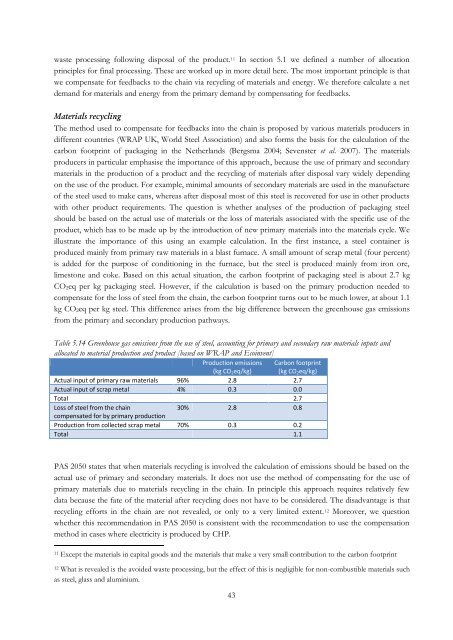Methodology for assessing carbon footprints of horticultural products
Methodology for assessing carbon footprints of horticultural products
Methodology for assessing carbon footprints of horticultural products
Create successful ePaper yourself
Turn your PDF publications into a flip-book with our unique Google optimized e-Paper software.
waste processing following disposal <strong>of</strong> the product. 11 In section 5.1 we defined a number <strong>of</strong> allocation<br />
principles <strong>for</strong> final processing. These are worked up in more detail here. The most important principle is that<br />
we compensate <strong>for</strong> feedbacks to the chain via recycling <strong>of</strong> materials and energy. We there<strong>for</strong>e calculate a net<br />
demand <strong>for</strong> materials and energy from the primary demand by compensating <strong>for</strong> feedbacks.<br />
Materials recycling<br />
The method used to compensate <strong>for</strong> feedbacks into the chain is proposed by various materials producers in<br />
different countries (WRAP UK, World Steel Association) and also <strong>for</strong>ms the basis <strong>for</strong> the calculation <strong>of</strong> the<br />
<strong>carbon</strong> footprint <strong>of</strong> packaging in the Netherlands (Bergsma 2004; Sevenster et al. 2007). The materials<br />
producers in particular emphasise the importance <strong>of</strong> this approach, because the use <strong>of</strong> primary and secondary<br />
materials in the production <strong>of</strong> a product and the recycling <strong>of</strong> materials after disposal vary widely depending<br />
on the use <strong>of</strong> the product. For example, minimal amounts <strong>of</strong> secondary materials are used in the manufacture<br />
<strong>of</strong> the steel used to make cans, whereas after disposal most <strong>of</strong> this steel is recovered <strong>for</strong> use in other <strong>products</strong><br />
with other product requirements. The question is whether analyses <strong>of</strong> the production <strong>of</strong> packaging steel<br />
should be based on the actual use <strong>of</strong> materials or the loss <strong>of</strong> materials associated with the specific use <strong>of</strong> the<br />
product, which has to be made up by the introduction <strong>of</strong> new primary materials into the materials cycle. We<br />
illustrate the importance <strong>of</strong> this using an example calculation. In the first instance, a steel container is<br />
produced mainly from primary raw materials in a blast furnace. A small amount <strong>of</strong> scrap metal (four percent)<br />
is added <strong>for</strong> the purpose <strong>of</strong> conditioning in the furnace, but the steel is produced mainly from iron ore,<br />
limestone and coke. Based on this actual situation, the <strong>carbon</strong> footprint <strong>of</strong> packaging steel is about 2.7 kg<br />
CO2eq per kg packaging steel. However, if the calculation is based on the primary production needed to<br />
compensate <strong>for</strong> the loss <strong>of</strong> steel from the chain, the <strong>carbon</strong> footprint turns out to be much lower, at about 1.1<br />
kg CO2eq per kg steel. This difference arises from the big difference between the greenhouse gas emissions<br />
from the primary and secondary production pathways.<br />
Table 5.14 Greenhouse gas emissions from the use <strong>of</strong> steel, accounting <strong>for</strong> primary and secondary raw materials inputs and<br />
allocated to material production and product [based on WRAP and Ecoinvent]<br />
Production emissions<br />
(kg CO 2eq/kg)<br />
43<br />
Carbon footprint<br />
(kg CO 2eq/kg)<br />
Actual input <strong>of</strong> primary raw materials 96% 2.8 2.7<br />
Actual input <strong>of</strong> scrap metal 4% 0.3 0.0<br />
Total 2.7<br />
Loss <strong>of</strong> steel from the chain<br />
compensated <strong>for</strong> by primary production<br />
30% 2.8 0.8<br />
Production from collected scrap metal 70% 0.3 0.2<br />
Total 1.1<br />
PAS 2050 states that when materials recycling is involved the calculation <strong>of</strong> emissions should be based on the<br />
actual use <strong>of</strong> primary and secondary materials. It does not use the method <strong>of</strong> compensating <strong>for</strong> the use <strong>of</strong><br />
primary materials due to materials recycling in the chain. In principle this approach requires relatively few<br />
data because the fate <strong>of</strong> the material after recycling does not have to be considered. The disadvantage is that<br />
recycling ef<strong>for</strong>ts in the chain are not revealed, or only to a very limited extent. 12 Moreover, we question<br />
whether this recommendation in PAS 2050 is consistent with the recommendation to use the compensation<br />
method in cases where electricity is produced by CHP.<br />
11 Except the materials in capital goods and the materials that make a very small contribution to the <strong>carbon</strong> footprint<br />
12 What is revealed is the avoided waste processing, but the effect <strong>of</strong> this is negligible <strong>for</strong> non-combustible materials such<br />
as steel, glass and aluminium.


